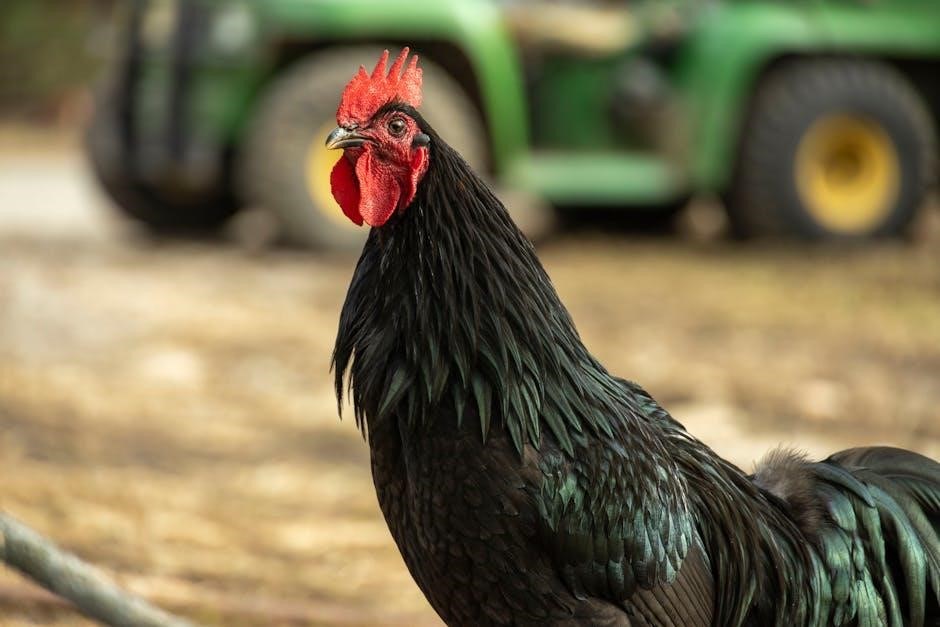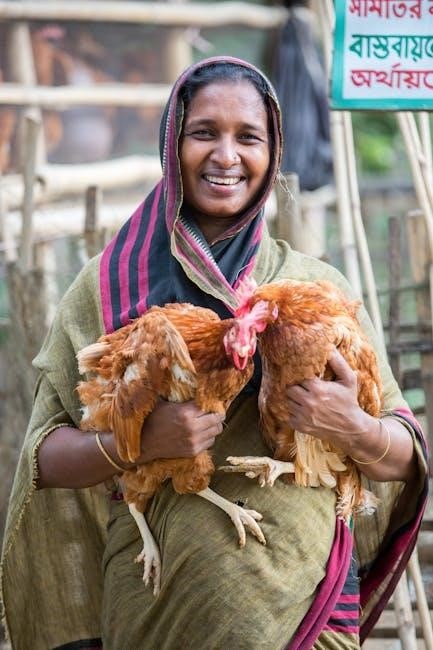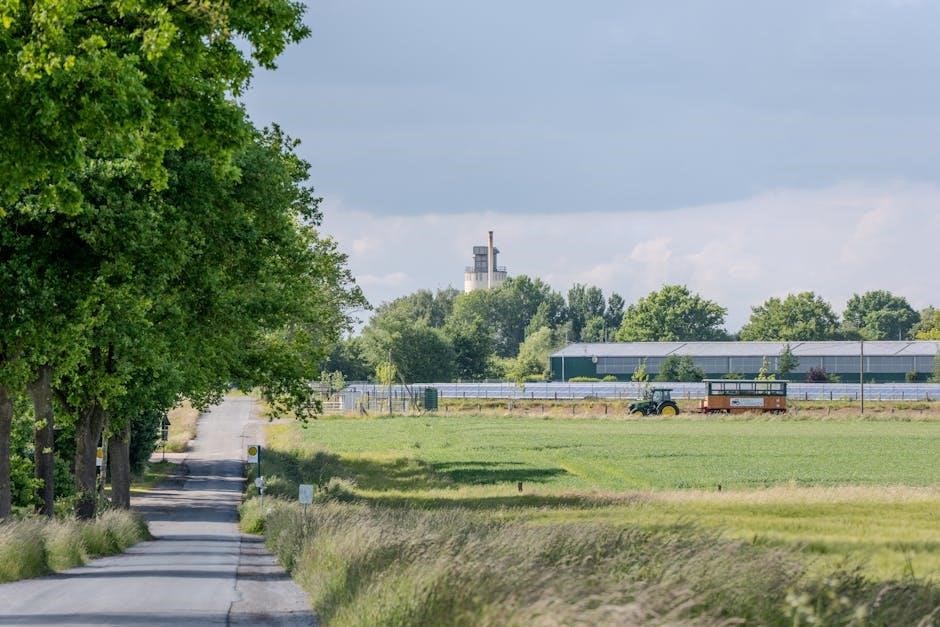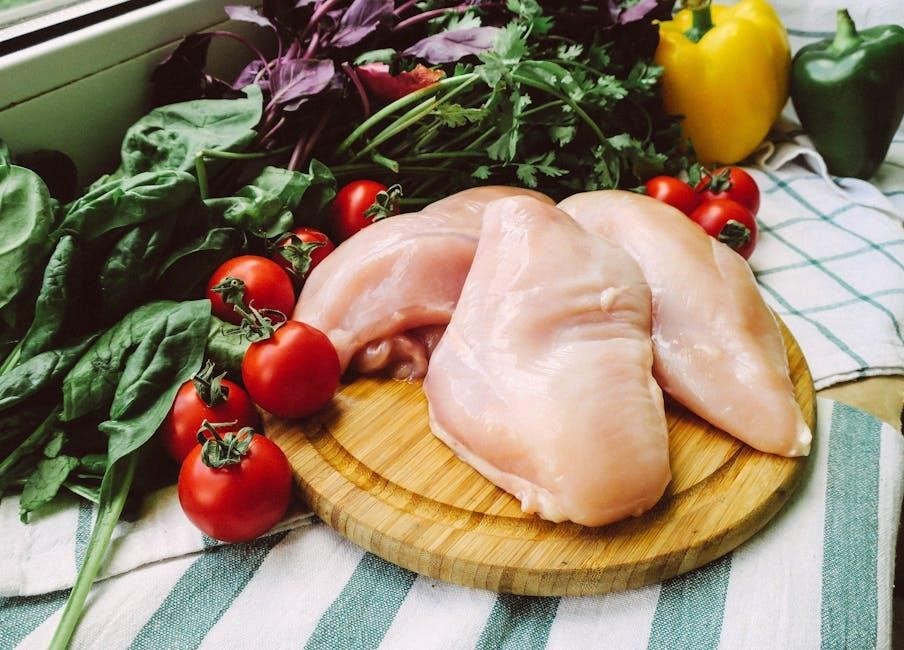chicken tractor plans pdf

Chicken tractor plans provide a comprehensive guide to building portable coops, offering space efficiency, cost-effectiveness, and ease of assembly. Perfect for backyard farmers, these designs ensure healthy, happy chickens while maintaining eco-friendly practices.
What is a Chicken Tractor?
A chicken tractor is a portable, enclosed structure designed to house chickens while allowing them to graze on fresh pasture. It is typically movable, enabling farmers to rotate pastures and maintain soil health. Unlike stationary coops, chicken tractors are lightweight and versatile, providing chickens with protection from predators and elements while promoting their natural foraging behavior. These structures are ideal for small-scale poultry farming and backyard flocks, offering a sustainable and efficient way to raise chickens. They come in various designs, such as A-frame or hoop coops, catering to different needs and spaces.
Benefits of Using a Chicken Tractor
A chicken tractor offers numerous benefits for backyard farmers and homesteaders. It provides a portable, secure enclosure for chickens, allowing them to graze on fresh pasture while protecting them from predators. The movable design promotes soil health by rotating grazing areas, reducing overgrazing and maintaining nutrient-rich land. It also encourages natural foraging behavior, which is beneficial for chicken health and reduces feed costs. Additionally, chicken tractors are space-efficient, making them ideal for small properties, and are often cost-effective to build. Their versatility and ease of use make them a practical choice for raising healthy, happy chickens sustainably.
Overall, a chicken tractor is a smart investment for anyone looking to integrate poultry into their farming or gardening lifestyle.
Why Choose DIY Chicken Tractor Plans?
Opting for DIY chicken tractor plans offers affordability, customization, and the satisfaction of creating a tailored solution for your flock. With detailed instructions and adaptable designs, these plans suit all skill levels, from beginners to experienced builders. DIY projects allow you to repurpose materials, reducing costs and environmental impact. Additionally, DIY plans often include tips for scalability, enabling you to expand or modify the tractor as your needs grow. This hands-on approach ensures your chicken tractor aligns perfectly with your specific requirements, making it a practical and rewarding choice for backyard farming.
Customization and cost-effectiveness make DIY plans a preferred option for many homesteaders.

Types of Chicken Tractor Plans

Chicken tractor plans vary widely, offering designs like A-Frame, Hoop Coop, and Salatin Style, each catering to different needs, budgets, and space requirements for backyard farming.
A-Frame Chicken Tractor Plans
A-Frame chicken tractor plans are a popular choice for their simplicity and durability. These designs feature a triangular roof, providing excellent protection from the elements while maintaining easy mobility. They are often constructed using lightweight materials like PVC pipes or metal frames, making them easy to move across pastures. The A-Frame structure allows for good ventilation and can be customized with nesting boxes and feeding systems. Many free PDF plans are available, offering step-by-step instructions for builders of all skill levels. This style is ideal for small to medium-sized flocks, ensuring your chickens stay safe and healthy.

Hoop Coop Chicken Tractor Plans
Hoop coop chicken tractor plans are ideal for their lightweight and affordable design. Constructed using cattle panels bent into a hoop shape and secured with a 2×4 frame, these coops are easy to assemble and highly portable. The open design offers excellent ventilation and visibility, while the lack of a floor allows chickens to forage naturally. Many free PDF plans include step-by-step instructions, making them accessible for DIY enthusiasts. These coops are perfect for small flocks and can be easily customized with nesting boxes or feeding systems. Their mobility ensures fresh grazing for your chickens, promoting healthy and productive poultry-keeping.
Salatin Style Chicken Tractor Plans
Salatin style chicken tractor plans, inspired by Joel Salatin’s pastured poultry methods, offer a practical solution for raising chickens on pasture. These large, movable coops, often measuring 12ft x 12ft x 2ft, can house 75-80 birds at 1.5 square feet per chicken. Designed for easy mobility, they feature handles and lightweight frames, allowing daily movement to fresh grazing areas. Free PDF plans emphasize durability and efficiency, using materials like pressure-treated lumber and wire mesh. These coops are ideal for homesteaders and farmers seeking to integrate chickens into regenerative farming systems, promoting sustainable and ethical poultry production.

Materials Needed for Building a Chicken Tractor
Essential materials include durable lumber, wire mesh, hardware cloth, roofing materials, and wheels. These components ensure structural integrity, predator protection, and mobility for your chicken tractor.
Lumber Requirements
Building a chicken tractor requires sturdy lumber to ensure durability and safety. Pressure-treated lumber is ideal for the frame, as it resists rot and pests. For the walls and floor, 2×4 or 2×2 boards are recommended, depending on the design. The roof may use lighter materials like 1×2 or 1×4 boards. Ensure all lumber is cut to precise measurements, and sand any rough edges to protect your chickens. The quantity of lumber needed will vary based on the size and complexity of your tractor, but having extra pieces for supports and doors is always a good idea.
Wire Mesh and Fencing Materials
Wire mesh and fencing materials are essential for securing your chicken tractor while providing ventilation and protection from predators. Use 1/2-inch hardware cloth for durability, as it resists chewing and bending. Attach the mesh securely to the frame using wire or staples, ensuring no gaps remain. For fencing, consider metal or wood panels to enclose the sides and back, while the front can have openings for airflow. Cover the top with sturdy wire mesh to prevent aerial predator access. Proper installation ensures your chickens stay safe and healthy, with adequate ventilation for comfort; Always prioritize predator-proof materials to safeguard your flock.
Roofing and Siding Options
When building a chicken tractor, selecting the right roofing and siding materials is crucial for durability and weather protection; Asphalt shingles or corrugated metal are popular roofing choices due to their water resistance and ease of installation. For siding, consider using recycled vinyl or wood planks to provide insulation and structural integrity. Ensure the materials are predator-proof and allow for proper ventilation. The back half of the tractor can be covered with a roof and sides, while the front remains open for airflow. Durable materials like metal or treated wood are ideal for withstanding outdoor conditions and protecting your flock from the elements.
Wheels and Mobility Features
Wheels and handles are essential for easy mobility, allowing you to move the chicken tractor daily for fresh ground. Use durable wheels with sturdy axles to ensure smooth movement. Handles made of wood or metal should be securely attached for better grip and control. The axle placement should distribute the weight evenly, preventing the tractor from tipping; Consider using large, heavy-duty wheels for easier maneuverability on uneven terrain. Mobility features ensure your flock always has access to fresh grass and clean living conditions, making the tractor both functional and user-friendly for backyard farming.

Step-by-Step Assembly Guide
This guide provides a clear, easy-to-follow process for building your chicken tractor, ensuring a sturdy and functional enclosure for your flock, perfect for all skill levels.
Assembling the Main Frame
Start by cutting and preparing the lumber according to your chicken tractor plans. Use pressure-treated wood for durability. Assemble the frame using 1 1/2 x 2 1/2 lumber for wall studs, ensuring corners are secure with screws and corner braces. Measure and cut additional boards to fit the design, ensuring the structure is square and sturdy. Sand all edges for safety. Attach beams to the bottom rails, double-checking alignment with a carpenter’s square. This step is crucial for stability and mobility, forming the foundation of your tractor. Add supports if needed for larger designs.
Installing the Wire Mesh and Hardware Cloth
Wrap the chicken tractor frame with wire mesh, excluding the bottom for ground contact. Use a staple gun to secure the mesh tightly. For added protection, attach hardware cloth to vulnerable areas like vents and nesting boxes. Ensure all edges are buried or bent inward to prevent predators from tearing the mesh. Check for gaps and reinforce seams with wire. Proper installation ensures ventilation and safety, keeping predators out while allowing airflow. Follow your plan’s specifications for mesh size and coverage to guarantee durability and effectiveness for your flock’s well-being.
Adding the Roof and Siding
Secure the roof to the frame using screws or nails, ensuring it is waterproof and durable. Metal roofing sheets or corrugated materials work well for weather protection. Attach siding to the walls, leaving space for ventilation. Use materials like plywood, metal, or reclaimed wood for siding, ensuring it is predator-proof. Align the siding with the roof for a seamless look and structural integrity. Proper installation of the roof and siding protects your chickens from harsh weather and extends the tractor’s lifespan. Follow your plan’s instructions for precise measurements and assembly to achieve a sturdy, weather-tight enclosure for your flock.
Attaching the Wheels and Handles
Attach wheels to the frame for easy mobility, ensuring they are sturdy and can handle the weight of the tractor. Use metal axles or bolts to secure the wheels firmly. Install handles on the opposite side for better grip and control while moving. Position the handles at a comfortable height to avoid straining. Ensure the wheels are aligned properly to maintain balance and prevent tilting. This step is crucial for making the tractor portable and user-friendly, allowing you to move it effortlessly across different areas of your yard or farm, ensuring fresh grazing for your chickens daily.

Key Considerations for Your Chicken Tractor
Ensure adequate space per chicken, proper ventilation, and predator-proof fencing. Mobility and ease of cleaning are also crucial for maintaining a healthy and productive environment for your flock.
Space Requirements Per Chicken
Providing adequate space is crucial for chicken health and productivity. Laying hens require at least 4 square feet per bird inside the tractor, while broilers need about half that space. Overcrowding can lead to stress and health issues. The space should also accommodate feeding, watering, and nesting areas. For example, a 12×12-foot tractor can comfortably house 75-80 birds at 1.5 square feet per chicken. Ensure your design balances flock size with movement and comfort to keep your chickens thriving and productive. Proper spacing enhances egg production and overall well-being, making it a key factor in successful chicken tractor planning.
Ventilation and Lighting
Ventilation and lighting are essential for maintaining a healthy environment inside a chicken tractor. Proper airflow prevents ammonia buildup from droppings, reducing stress and health issues. Incorporate windows, vents, or mesh panels to ensure fresh air circulation. Natural lighting is ideal, but if artificial light is needed, use low-wattage options to avoid overheating. Avoid direct sunlight on the tractor to prevent heat stress. Ensure the design balances ventilation with predator protection, using materials like hardware cloth for secure airflow. Adequate lighting and airflow promote comfort, egg production, and overall chicken well-being, making them critical components of effective chicken tractor plans.
Predator Protection and Security
Predator protection is crucial for safeguarding your flock. Use hardware cloth or sturdy wire mesh with openings no larger than 1 inch to prevent predators like raccoons or foxes from breaching the tractor. Ensure all enclosures are secure, with no gaps or weak points. Cover the top and sides with durable materials to deter aerial predators. Consider adding a locking mechanism to the doors and nesting boxes. Regularly inspect the tractor for damage or vulnerabilities. Burying hardware cloth 12 inches underground around the tractor can prevent digging predators. A well-secured chicken tractor ensures your chickens remain safe from potential threats, providing peace of mind for backyard farmers.

Advanced Features for Your Chicken Tractor
Enhance your chicken tractor with nesting boxes, automated feeding systems, and easy-cleaning designs. These features improve efficiency, reduce maintenance, and ensure a healthier environment for your flock.
Nesting Boxes and Egg Collection
Integrating nesting boxes into your chicken tractor is essential for egg production. Ensure each box is 12×12 inches with soft bedding for comfort. Position them at waist height to prevent strain and deter predators. Include a sloped roof and easy-clean features to maintain hygiene. Consider adding a roll-out tray system for effortless egg collection. These designs, often detailed in chicken tractor plans PDFs, maximize space while encouraging consistent egg laying. Properly designed nesting boxes can significantly improve both egg quality and your overall farming experience.

Feeding and Watering Systems
Efficient feeding and watering systems are crucial for a productive chicken tractor. Incorporate troughs or feeders that are easy to access and clean, minimizing waste and mess. Automatic water dispensers or nipple drinkers are ideal for maintaining hygiene and ensuring constant water supply. Mount these systems securely to prevent tipping and ensure they are elevated to reduce contamination. Some plans include portable feed and water containers that move with the tractor, saving time and effort. These designs, often detailed in chicken tractor plans PDFs, enhance flock health and simplify daily maintenance for backyard farmers.
Easy Cleaning and Maintenance
Easy cleaning and maintenance are essential for a functional chicken tractor. Designs often include removable roofs, slide-out droppings trays, and washable surfaces to simplify sanitation. Open frameworks and accessible interiors allow for quick cleaning without dismantling the structure. Durable, weather-resistant materials like metal or recycled plastic are ideal for withstanding frequent cleaning. Some plans incorporate tilting or hinged features for easy access to nesting boxes and feeding areas. Regular maintenance checks ensure the tractor remains secure and predator-proof, while removable parts make repairs straightforward. These features, detailed in many chicken tractor plans PDFs, ensure longevity and efficiency for backyard farming setups.

Budget-Friendly Chicken Tractor Plans
Discover affordable DIY solutions with budget-friendly chicken tractor plans. Utilize recycled materials, free PDF guides, and cost-effective strategies to build a durable, eco-friendly enclosure for your flock.
Using Recycled Materials
Building a chicken tractor with recycled materials is a budget-friendly and eco-conscious approach. Consider repurposing items like old pallets, fencing, or metal frames to construct the main structure. Pallets can be disassembled for lumber, while wire mesh from discarded fencing can serve as enclosure material. Even old roofing sheets or siding can be reused for the tractor’s top and sides. Websites like Craigslist often have free or low-cost materials perfect for upcycling. By creatively repurposing these items, you reduce waste and lower costs, ensuring your chicken tractor is both durable and environmentally friendly. This method also adds a personal touch to your project, making it uniquely yours.
Free PDF Plans and Resources
Accessing free PDF plans for chicken tractors is a great way to start your project. Websites like Emerald Lake Books and Green Willow Homestead offer detailed designs, including Salatin-style and A-frame models. These plans often include material lists, step-by-step instructions, and creative tips for customization. Platforms like Craigslist and DIY forums also share free blueprints, perfect for small-scale backyard farming. Additionally, many homesteading blogs provide downloadable PDF guides, ensuring you can build a functional and eco-friendly chicken tractor without breaking the bank. These resources are ideal for beginners and experienced builders alike, offering inspiration and practical advice for your project.
Chicken tractor plans offer a cost-effective, eco-friendly way to raise poultry. With free PDF resources available, you can easily build a safe, efficient coop for your flock.
Final Tips for Building Your Chicken Tractor
Ensure proper ventilation and lighting for your flock’s health. Use durable materials like hardware cloth for predator protection. Consider space requirements, with at least 4 square feet per hen. Incorporate nesting boxes and feeding systems for efficiency. Regularly move the tractor to maintain fresh ground and reduce waste buildup. Utilize recycled materials to cut costs and minimize environmental impact. Follow detailed PDF plans for accuracy and consult online guides for troubleshooting. Always prioritize your chickens’ safety and comfort to create a thriving backyard farm environment.
Where to Find the Best Chicken Tractor Plans PDF
The best chicken tractor plans PDF can be found on websites like Emerald Lake Books and other homesteading platforms. These resources often include detailed designs, material lists, and step-by-step instructions. Look for free or paid plans that suit your skill level and flock size. Platforms like Pinterest, YouTube, and specialized farming forums also offer a wealth of downloadable guides. Ensure the plans are comprehensive, secure, and tailored to your specific needs for a successful build. Always verify the source for quality and safety.